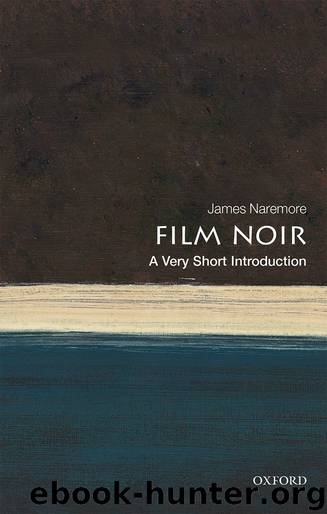Film Noir by James Naremore

Author:James Naremore
Language: eng
Format: epub
ISBN: 9780192509512
Publisher: Oxford University Press
Published: 2018-12-21T00:00:00+00:00
The other side of town
Much could be written (and has been) about the cultural politics of film noir, which has been affected not only by such official agencies as the PCA, but also, more indirectly, by the general culture’s treatment of women and minorities. One reason noir is interesting from this perspective is that it has so many “in-between” or mixed qualities: it occupies a liminal space between art and potboilers; it involves both action pictures and “women’s” melodramas; it often centers on a zone between the law and the underworld; and its action keeps moving back and forth between respectable and disreputable areas of town, bringing together people of different status. (As art-dealer Clifton Webb remarks in The Dark Corner, the fancy parties he gives are “a nauseating mixture of Park Avenue and Broadway.”) Sometimes—most conspicuously in Touch of Evil—it involves crossing and re-crossing actual borders. Aside from frontier westerns about cowboys and Indians, it offers middle-class white audiences their most frequent opportunity to see “others”: sexually independent women, homosexuals, Asians, Latins, and blacks.
Feminist film critics and theorists share no single position on the sexual politics of noir, in part because many classic examples displace the patriarchal family in favor of lone wolves and spider women. Although the noir femme fatale has origins in male fears of modern women, and although she usually comes to a bad end, she nevertheless remains a threat to the proper order of things and does what E. Ann Kaplan describes as important “ideological work.” Some of this work is made explicit in The Big Heat, when gangster’s moll Gloria Grahame confronts the widow of a police chief, describing herself and her apparent opposite as “sisters under the mink.” Many noir films in the 1940s try to contrast the tough, sexy bad girl with the housewife and mother or the virginal innocent (examples can be seen in Double Indemnity, The Big Heat, and Out of the Past), but the bad girl is always the most fascinating character. Certain of the films play with this good/bad distinction in interesting and potentially subversive ways: see especially Pitfall (1948) and The Narrow Margin (1952). Notice also that certain noir-like women’s melodramas undercut the formula for what Hollywood once called “women’s weepies.” R. Barton Palmer has pointed out that Possessed and Cause for Alarm (1947) differ from a non-noir melodrama such as Now, Voyager (1942) because they don’t offer a “compromised yet satisfying wish fulfillment—that is, the heroine put back in her place but offered a different, rewarding life.”
An equally mixed set of responses can be found in discussions of noir masculinity and homosexuality. Although the Production Code of the 1940s explicitly forbade the depiction of homosexuality, the repressed returned in various ways. The tough, masculine novels of Hammett and Chandler had latently homosexual characters that were transposed into the films. Sometimes homosexuality was stereotyped, as in Bogart’s imitation of a lisping bibliophile in The Big Sleep, but more often the villains were subtly portrayed as homosexual, as in The Maltese Falcon, Rope (1948), The Big Heat, and Strangers on a Train.
Download
This site does not store any files on its server. We only index and link to content provided by other sites. Please contact the content providers to delete copyright contents if any and email us, we'll remove relevant links or contents immediately.
The Kite Runner by Khaled Hosseini(5085)
Gerald's Game by Stephen King(4584)
Dialogue by Robert McKee(4326)
The Perils of Being Moderately Famous by Soha Ali Khan(4171)
The 101 Dalmatians by Dodie Smith(3454)
Story: Substance, Structure, Style and the Principles of Screenwriting by Robert McKee(3399)
The Pixar Touch by David A. Price(3369)
Confessions of a Video Vixen by Karrine Steffans(3247)
How Music Works by David Byrne(3190)
Fantastic Beasts: The Crimes of Grindelwald by J. K. Rowling(2996)
Harry Potter 4 - Harry Potter and The Goblet of Fire by J.K.Rowling(2992)
Slugfest by Reed Tucker(2944)
The Mental Game of Writing: How to Overcome Obstacles, Stay Creative and Productive, and Free Your Mind for Success by James Scott Bell(2847)
4 - Harry Potter and the Goblet of Fire by J.K. Rowling(2657)
Screenplay: The Foundations of Screenwriting by Syd Field(2576)
The Complete H. P. Lovecraft Reader by H.P. Lovecraft(2514)
Scandals of Classic Hollywood: Sex, Deviance, and Drama from the Golden Age of American Cinema by Anne Helen Petersen(2467)
Wildflower by Drew Barrymore(2445)
Robin by Dave Itzkoff(2387)
